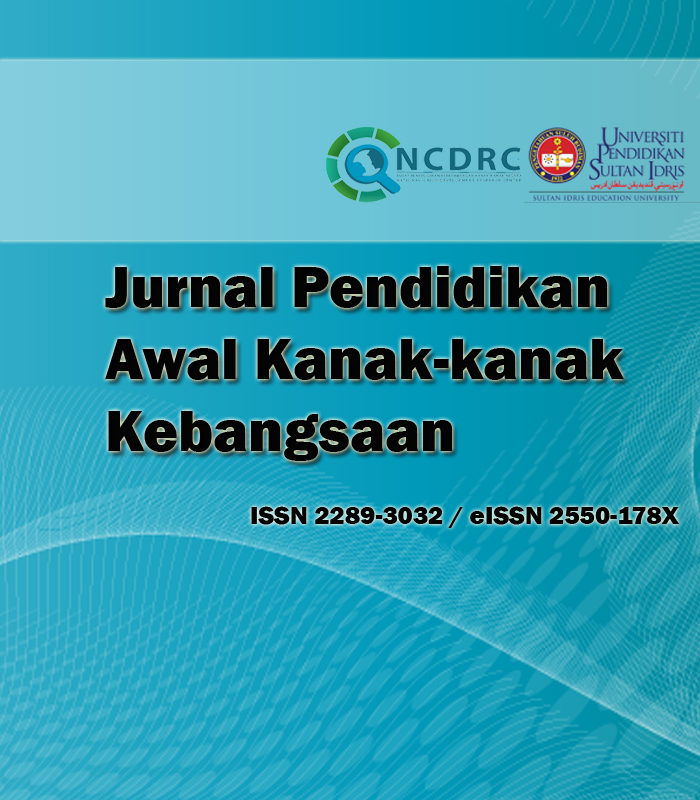Multi-Sensory Activity in Early Childhood Education: The Barriers to Implementation of Activities by Teachers
DOI:
https://doi.org/10.37134/jpak.vol13.2.2.2024Keywords:
Multi-sensory, activity, early childhood education, teacher, barrier, implementationAbstract
The purpose of this study was to survey the barriers to implementation of multi-sensory activities by teachers. Perception among early childhood education teachers is seen based on teachers’ responds toward the barriers in implementing multi-sensory activities in their teaching and learning process. This study is a survey study using a questionnaire and the questions were evaluated based on frequency, percentage, one-way Anova and T-Test. The respondents involved in this study are teachers of early childhood education in Muallim District, Perak. The total number of respondents involved is 30 teachers. The findings of the study found that the greatest barrier for teacher in the implementation of multi-sensory activities in early childhood education is lack of equipment while the least barrier faced by teacher is in term of parent opposition. Other than that, even there are not significant, but by mean score, a teacher with Bachelor Degree and Master Degree more likely facing a barriers to implementation of Multi-sensory activities. The findings also found that teachers who did not attend any courses related to multi-sensory activities faced more barrier with (M=20.85) compared to teachers who have attended related courses with (M=18.90).
Downloads
References
Abdul Halim Masnan (2014). Amalan Pedagogi Guru Prasekolah Permulaan. Pulau Pinang: Universiti Sains Malaysia. Tesis Doktor Falsafah.
Baines, L. (2008). A Teacher's Guide to Multisensory Learning: Improving Literacy by Engaging the Senses. USA: Julie Houtz.
Davies, C. (2019). Creating Multi-sensory Environments: Practical Ideas for Teaching and Learning. New York: Routledge.
Denham, S.A., Bassett, H.H., & Zinsser, K. (2012). Early Childhood Teachers as Socializer of Young Children’s Emotional Competence. Early Childhood Education Journal, 40, 137-143.
Ducusin, Ria Jhoanna & Dy, Marison. (2016). Parental Perceptions on the Importance of Play in Early Childhood. Journal of Human Ecology, 5. 1-18.
Gascoyne, S. (2011). Sensory Play: Play in the EYFS. London: MA Education Ltd.
Hamdan Salleh & Affezah Ali & Angela Chan (2017). Analisa Keperluan Latihan Guru-Guru Sekolah Rendah Agama Di Selangor. National Pre University Seminar. http://www.ccsenet.org/journal/index.php/ies/article/view/0/44463.
Hasan, N. D., & Zaini, S. H. (2021). Application of social skills to children through role-playing activities. Jurnal Pendidikan Awal Kanak-Kanak Kebangsaan,10(1), 25-40. https://doi.org/10.37134/jpak.vol10.1.3.2021
Holloway, I., & Wheeler, S. (2013). Qualitative Research in Nursing and Healthcare.3rd Edition. United Kingdom: John Wiley & Son.
Kementerian Pelajaran Malaysia. (2012). Bidang Keberhasilan Utama Nasional (NKRA) Pendidikan. Kuala Lumpur: Kementerian Pendidikan Malaysia.
Koenig, K. P., & Rudney, S. G. (2010). Performance challenges for children and Adolescents with difficulty processing and integrating sensory information: A systematic review American Journal of Occupational Therapy, 64, 430–442.
Libau, C.M., & Ling, Y.L. (2020). Peranan Bahan Bantu Mengajar dan Persekitaran Maklum Balas Dalam Meningkatkan Kualiti Pembelajaran Pelajar. National Research Innovation Conference (NRICon 2020), Kuching, Sarawak.
Masnan, A. H., Anthony, N. E., & Zainudin, N. A. S. (2019). Pengetahuan pengajaran dalam kalangan guru prasekolah. Jurnal Pendidikan Awal Kanak-Kanak Kebangsaan, 8, 33-41. https://doi.org/10.37134/jpak.vol8.5.2019
Muhamad Fadzil, N., & Fadhil, F. (2019). Meaningful Learning Through Games "Cardboard Challenge Game (60 - 65). Jurnal Pendidikan Bitara UPSI, 9(2), 60-65.
Muhammad Haziq Mohd Sharif (2019). Amalan Bersesuaian Perkembangan sebagaivKompetensi Profesional Guru dalam Pendidikan Prasekolah. Journal of Educational Research and Indigenous Studies, 2(1), 1-10.
Mutillo, C.M., Grau, P.G., & Valero, R.F. (2020). Interpersonal Relationship in Early Childhood. IntechOpen
Pagliano, P. (2017). Multisensory Environment. New York: David Fulton Publishers.
UNICEF. (2012). Inequalities in Early Childhood Development: What the Data Say. New York, NY 10017, USA UNICEF. (n.d.). Fact sheet: A summary of the rights under the Convention on the Rights of the Child. Retrieved February 8, 2021 from https://www.unicef.org/crc/files/Rights_overview.pdf
Vanan M.M. (2020). The Awareness About Teacher Education In Education Policy(2019) among Teacher Educators in Madurai District. Mahila Pratishtha. 5(4). 122-127.
Yaswinda (2018). Development of a Procedural Model of Science Based on Multisensory-Ecology for Early Childhood Education. Adv. Soc. Sci.Educ. Humanit, 1(169), 164–167.
Downloads
Published
How to Cite
Issue
Section
License
Copyright (c) 2022 Syazwani Aniyah Manja, Abdul Halim Masnan, Mazlina Che Mustafa, Syahirah Moktar

This work is licensed under a Creative Commons Attribution-NonCommercial-ShareAlike 4.0 International License.





